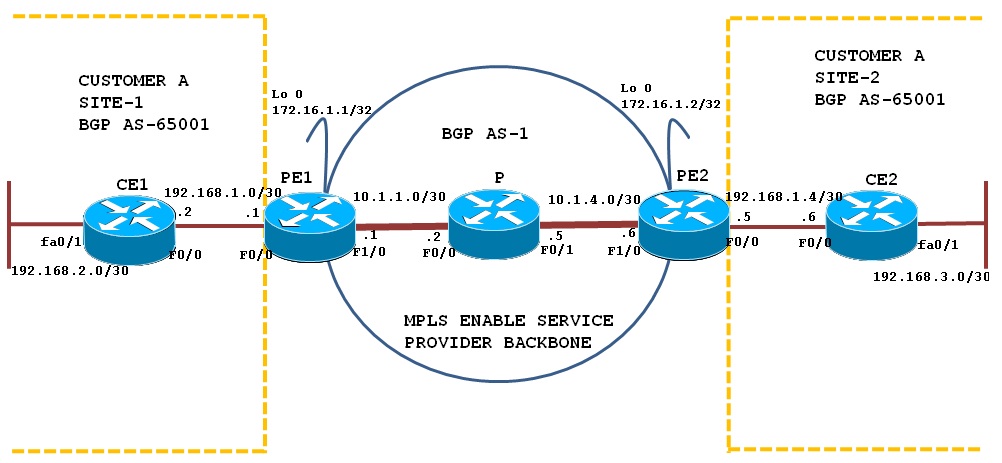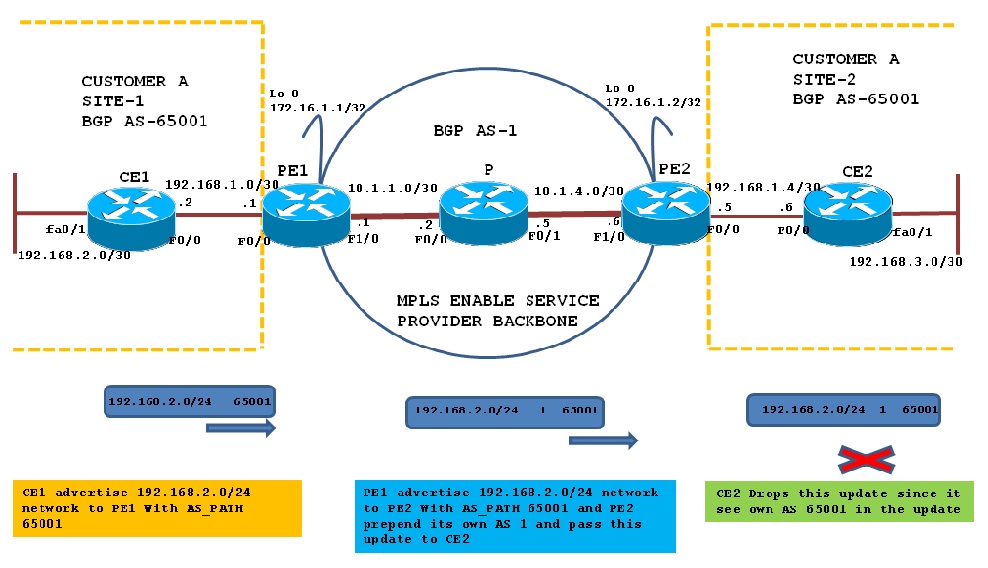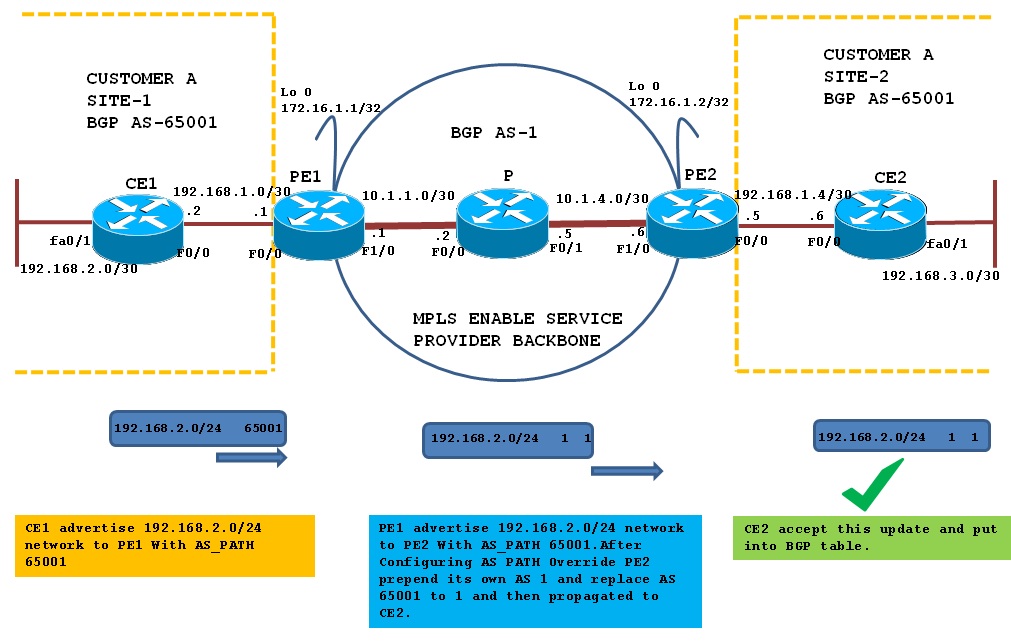- Cisco Community
- Technology and Support
- Service Providers
- Service Providers Knowledge Base
- BGP PE-CE Routing Protocol Overview In MPLS VPNs-Part II
- Subscribe to RSS Feed
- Mark as New
- Mark as Read
- Bookmark
- Subscribe
- Printer Friendly Page
- Report Inappropriate Content
- Subscribe to RSS Feed
- Mark as New
- Mark as Read
- Bookmark
- Subscribe
- Printer Friendly Page
- Report Inappropriate Content
04-28-2013 12:23 PM - edited 08-29-2017 09:32 AM
- Introduction:
- Topology Diagram:
- BGP loop prevention Mechanism:
- BGP AS Override feature:
- Configuration Overview:
- Configuration Steps for BGP PE-CE routing:
- Verification of BGP PE-CE Routing Implemention:
- Related Information:
Introduction:
In previous document we have seen implementation of MPLS VPN BGP PE-CE routing protocol in which customer was using different AS number between their sites. In this document we will see BGP PE-CE sites implementation using same AS numbers.
If customer use the same AS number between his sites, the BGP loop prevention mechanism disallows customer sites having identical AS numbers to be linked by another AS number. In other words, routing updates from one site would be dropped when the other site receives them; therefore, connectivity cannot be established between the sites without additional configuration on the Service provider PE routers.
Topology Diagram:
This configuration scenario demonstrates BGP PE-CE routing for VPN sites using same BGP AS numbers. The above topology shows Customer A is using BGP AS 65001 for Site-1 and 65001 at Sites 2.

BGP loop prevention Mechanism:
When CE1 send its routing information update Over BGP VPNv4 and reached to CE2 via PE2, CE2 checks the update and finds AS 65001 in the AS-PATH ; therefore due to BGP loop prevention mechanism CE2-B rejects the 192.168.2.0/24 update from PE2 because it finds its own AS in the update.

BGP AS Override feature:
To overcome above problem you can use BGP AS Override functionality on PE routers. The AS Override function causes all leading occurrences of the AS number of the receiving BGP router to be replaced with the AS number of the sending BGP router.
When you use BGP AS Override functionality, PE2 router will replace AS 65001 in the AS-PATH with its own AS number, which is 1 and send it to CE2 as shown below in diagram:

Configuration Overview:
Basic Configuration:
PE1 Router:
PE2 Router:
P Router
CE1 Router
CE2 Router
hostname PE1 ip cef ! interface Loopback0 ip address 172.16.1.1 255.255.255.255 ! interface FastEthernet0/0 ip address 192.168.1.1 255.255.255.252 duplex auto speed auto ! interface FastEthernet1/0 ip address 10.1.1.1 255.255.255.252 speed 100 full-duplex mpls ip ! router ospf 100 log-adjacency-changes network 10.1.1.1 0.0.0.0 area 0 network 172.16.1.1 0.0.0.0 area 0 ! router bgp 1 no synchronization bgp log-neighbor-changes neighbor 172.16.1.2 remote-as 1 no auto-summary ! address-family vpnv4 neighbor 172.16.1.2 activate neighbor 172.16.1.2 send-community extended exit-address-family ! mpls ldp router-id Loopback0
| hostname PE2 ip cef ! interface Loopback0 ip address 172.16.1.2 255.255.255.255 ! interface FastEthernet0/0 ip address 192.168.1.5 255.255.255.252 duplex auto speed auto ! interface FastEthernet1/0 ip address 10.1.1.6 255.255.255.252 speed 100 full-duplex mpls ip ! router ospf 100 log-adjacency-changes network 10.1.1.6 0.0.0.0 area 0 network 172.16.1.2 0.0.0.0 area 0 ! router bgp 1 no synchronization bgp log-neighbor-changes neighbor 172.16.1.1 remote-as 1 neighbor 172.16.1.1 update-source Loopback0 no auto-summary ! address-family vpnv4 neighbor 172.16.1.1 activate neighbor 172.16.1.1 send-community extended exit-address-family ! mpls ldp router-id Loopback0 | hostname P ip cef ! interface FastEthernet0/0 ip address 10.1.1.2 255.255.255.252 mpls ip ! interface FastEthernet0/1 ip address 10.1.1.5 255.255.255.252 mpls ip ! router ospf 100 log-adjacency-changes network 10.1.1.0 0.0.0.7 area 0
| hostname CE1 ip cef ! interface FastEthernet0/0 ip address 192.168.1.2 255.255.255.252 ! interface FastEthernet0/1 ip address 192.168.2.1 255.255.255.0 ! router bgp 65001 no synchronization bgp log-neighbor-changes network 192.168.2.0 mask 255.255.255.0 neighbor 192.168.1.1 remote-as 1 no auto-summary
|
hostname CE2 ip cef ! interface FastEthernet0/0 ip address 192.168.1.6 255.255.255.252 ! interface FastEthernet0/1 ip address 192.168.3.1 255.255.255.0 ! router bgp 65001 no synchronization bgp log-neighbor-changes network 192.168.3.0 mask 255.255.255.0 neighbor 192.168.1.5 remote-as 1 no auto-summary
|
We have BGP vpnv4 neighbors hip up between PE1 and PE2 can be verify as shown below:
PE1#sh ip bgp vpnv4 all summary | beg Nei
Neighbor V AS MsgRcvd MsgSent TblVer InQ OutQ Up/Down State/PfxRcd
172.16.1.2 4 1 11 11 1 0 0 00:08:43 0
PE2#sh ip bgp vpnv4 all summary | beg Nei
Neighbor V AS MsgRcvd MsgSent TblVer InQ OutQ Up/Down State/PfxRcd
172.16.1.1 4 1 11 11 1 0 0 00:08:21 0
Configuration Steps for BGP PE-CE routing:
Step 1:Define VRF Cust_A on PE Routers PE1 and PE2:
Define VRF Cust_A on PE Routers PE1 and PE2 and apply on VRF on Physical interface facing customer.
PE1#conf t
PE1(config)#ip vrf Cust_A
PE1(config-vrf)#description Customer-A
PE1(config-vrf)# rd 1:100
PE1config-vrf)# route-target both 1:100
PE1(config)#int fa0/0
PE1(config-if)#ip vrf forwarding Cust_A
PE1(config-if)#ip add 192.168.1.1 255.255.255.252
PE1(config-if)#exit
PE2#conf t
PE2(config)#ip vrf Cust_A
PE2(config-vrf)#description Customer-A
PE2(config-vrf)# rd 1:100
PE2config-vrf)# route-target both 1:100
PE2(config-vrf)#exit
PE2(config)#int fa0/0
PE2(config-if)#ip vrf forwarding Cust_A
PE2(config-if)#ip add 192.168.1.5 255.255.255.252
PE2(config-if)#exit
Step 2:Configure per VRF BGP routing context on PE routers; Define & Activate BGP CE neighbors:
Configure per VRF BGP routing for Cust_A under the BGP routing process on PE1 and PE2 and under the BGP VRF routing context mention the remote BGP CE neighbors and activated as shown below.
PE1#conf t
Enter configuration commands, one per line. End with CNTL/Z.
PE1(config)#router bgp 1
PE1(config-router)#address-family ipv4 vrf Cust_A
PE1(config-router-af)#neighbor 192.168.1.2 remote-as 65001
PE1(config-router-af)#neighbor 192.168.1.2 activate
PE1(config-router-af)#exit
PE2#conf t
Enter configuration commands, one per line. End with CNTL/Z.
PE2(config)#router bgp 1
PE2(config-router)#address-family ipv4 vrf Cust_A
PE2(config-router-af)#nei 192.168.1.6 remote-as 65001
PE2(config-router-af)#nei 192.168.1.6 activate
PE2(config-router-af)#exit
Step 3:Configure BGP AS Override command on PE1 and PE2 under BGP VRF address family:
PE1#conf t
Enter configuration commands, one per line. End with CNTL/Z.
PE1(config)#router bgp 1
PE1(config-router)#address-family ipv4 vrf Cust_A
PE1(config-router-af)#neighbor 192.168.1.2 as-override
PE1(config-router-af)#exit
PE2#conf t
Enter configuration commands, one per line. End with CNTL/Z.
PE2(config)#router bgp 1
PE2(config-router)#address-family ipv4 vrf Cust_A
PE2(config-router-af)#neighbor 192.168.1.6 as-override
PE2(config-router-af)#exit
Verification of BGP PE-CE Routing Implemention:
Step 1:Verify BGP neighbor relationship on PE1 and PE2 with CE1 and CE2 respectively:
Verify the BGP neighbor relationship between PE-CE routers. Below output shows that the BGP neighbor relationship is established between PE1 and CE1 and PE2 with CE2.
PE1#sh bgp vpnv4 unicast vrf Cust_A summary | beg Nei
Neighbor V AS MsgRcvd MsgSent TblVer InQ OutQ Up/Down State/PfxRcd
192.168.1.2 4 65001 16 16 4 0 0 00:11:32 1
PE2#sh bgp vpnv4 unicast vrf Cust_A summary | beg Nei
Neighbor V AS MsgRcvd MsgSent TblVer InQ OutQ Up/Down State/PfxRcd
192.168.1.6 4 65002 13 13 4 0 0 00:08:24 1
Step 2:Verify BGP VPNv4 routing table on PE1 and PE2:
PE1 has two prefixes in the BGP table from the remote PE router, 192.168.2.0 is learn from CE1 and 192.168.3.0 from PE2
PE1#sh bgp vpnv4 unicast vrf Cust_A
BGP table version is 4, local router ID is 172.16.1.1
Status codes: s suppressed, d damped, h history, * valid, > best, i - internal,
r RIB-failure, S Stale
Origin codes: i - IGP, e - EGP, ? - incomplete
Network Next Hop Metric LocPrf Weight Path
Route Distinguisher: 1:100 (default for vrf Cust_A)
*> 192.168.2.0 192.168.1.2 0 0 65001 i
*>i192.168.3.0 172.16.1.2 0 100 0 65002 i
Similar output is also seen on PE2
PE2#sh bgp vpnv4 unicast vrf Cust_A
BGP table version is 4, local router ID is 172.16.1.2
Status codes: s suppressed, d damped, h history, * valid, > best, i - internal,
r RIB-failure, S Stale
Origin codes: i - IGP, e - EGP, ? - incomplete
Network Next Hop Metric LocPrf Weight Path
Route Distinguisher: 1:100 (default for vrf Cust_A)
*>i192.168.2.0 172.16.1.1 0 100 0 65001 i
*> 192.168.3.0 192.168.1.6 0 0 65002 i
Step 3:Check the VRF routing table on both PE:
Check the routing table of VRF Cust_A must show routes learn from neigboring PE
PE1#sh ip route vrf Cust_A | beg Gate
Gateway of last resort is not set
192.168.1.0/30 is subnetted, 1 subnets
C 192.168.1.0 is directly connected, FastEthernet0/0
B 192.168.2.0/24 [20/0] via 192.168.1.2, 00:28:37
B 192.168.3.0/24 [200/0] via 172.16.1.2, 00:24:58
PE2#sh ip route vrf Cust_A | beg Gate
Gateway of last resort is not set
192.168.1.0/30 is subnetted, 1 subnets
C 192.168.1.4 is directly connected, FastEthernet0/0
B 192.168.2.0/24 [200/0] via 172.16.1.1, 00:28:56
B 192.168.3.0/24 [20/0] via 192.168.1.6, 00:25:31
Step 4:Verify end-to-end connectivity:
Verifying end-to-end connectivity between CE1 and CE2 by issuing a ping from CE1 to network 192.168.3.1/24 on CE2 and vice versa
CE1#ping 192.168.3.1 so 192.168.2.1
Type escape sequence to abort.
Sending 5, 100-byte ICMP Echos to 192.168.3.1, timeout is 2 seconds:
Packet sent with a source address of 192.168.2.1
!!!!!
Success rate is 100 percent (5/5), round-trip min/avg/max = 56/76/104 ms
CE2#ping 192.168.2.1 so 192.168.3.1
Type escape sequence to abort.
Sending 5, 100-byte ICMP Echos to 192.168.2.1, timeout is 2 seconds:
Packet sent with a source address of 192.168.3.1
!!!!!
Success rate is 100 percent (5/5), round-trip min/avg/max = 52/84/104 ms
Related Information:
- Mark as Read
- Mark as New
- Bookmark
- Permalink
- Report Inappropriate Content
Good work Ashish
- Mark as Read
- Mark as New
- Bookmark
- Permalink
- Report Inappropriate Content
Dear Thanveer,
"Thank you! I truly appreciate your positive feedbacks."
Regards,
Ashish Shirkar
Technical community manager(Network Infrastructure)
- Mark as Read
- Mark as New
- Bookmark
- Permalink
- Report Inappropriate Content
i am studying CCIE lab exam and come across PE-CE configuration, thank you Ashish for this article, good job
- Mark as Read
- Mark as New
- Bookmark
- Permalink
- Report Inappropriate Content
Hello bahaa,
Thanks for your feedback,Keep learning and share your knowledge with others.
Best of luck for you CCIE certification journey
Regards,
Ashish
Technical Community Manager - Network Infrastructure
- Mark as Read
- Mark as New
- Bookmark
- Permalink
- Report Inappropriate Content
Very informative and good understanding .
Thanks Ashish
- Mark as Read
- Mark as New
- Bookmark
- Permalink
- Report Inappropriate Content
Hi Sandeep ,
Thanks for your feedback
Regards,
Ashish Shirkar
- Mark as Read
- Mark as New
- Bookmark
- Permalink
- Report Inappropriate Content
Hi Ashish thi is a very good walkthrough for a newbie in these topics. I a about to finish y simulation of this scenario, I got the same output of the show commands but unable to ping from end to end. Might I missed something in the vrf part?
Regards
Jorge
- Mark as Read
- Mark as New
- Bookmark
- Permalink
- Report Inappropriate Content
Hi Jorge,
I I’m not sure what you have missed in your config but if you are trying to ping from CE without using source ip address(CE1#ping 192.168.3.1) then you also need to advertise connected interface in BGP.
On PE configure,
router bgp 1
address-family ipv4 unicast vrf Cust_A
redistribute conncted
If your config is same as above then make sure you configure mpls ip command on each interface facing core.Also check your routing table on CE to ensure you have all routes.
Let me know still if you face any problem
Regards,
Ashish
- Mark as Read
- Mark as New
- Bookmark
- Permalink
- Report Inappropriate Content
Hi Ashish,
what if i only want to forward a Default-route from CE1 (which is receiving it from another CE) to CE2.
and CE2 doesnt need to know any specific prefixes from CE1 expect the default-route.
well this is the multi-home.
I am trying to play with the vrf import/export, but i am not able to figure it out.
appreciate it if you share your thoughts/.
Ahmad
- Mark as Read
- Mark as New
- Bookmark
- Permalink
- Report Inappropriate Content
Got my answer :) thanks anyway
- Mark as Read
- Mark as New
- Bookmark
- Permalink
- Report Inappropriate Content
nice guide
- Mark as Read
- Mark as New
- Bookmark
- Permalink
- Report Inappropriate Content
Excellent guide!!
Now I want to know if there's a way to implement load balancing connected with two ISP.
For example, CE1 and CE2 connected to another PE with BGP AS-2.
If you have another guide with that, would be great!!
Best regards
- Mark as Read
- Mark as New
- Bookmark
- Permalink
- Report Inappropriate Content
Hi ,
Thanks for you feedback,Checkout bgp peek for loadbalancing.
Regards,
Ashish
- Mark as Read
- Mark as New
- Bookmark
- Permalink
- Report Inappropriate Content
Hi,
I'm quite similar configuration like this on my lab environment, but my CEs are receiving routes of others CEs through their PEs but can ping the internal route on those sites.
I've noticed on your PE1 configuration you don't show where you tell the router the AS of the peer CE, if don't put that information how the PE know what AS is its peer?
Thanks
- Mark as Read
- Mark as New
- Bookmark
- Permalink
- Report Inappropriate Content
Just to clarify, the information you mention is in the PE1 Basic Configuration.
router bgp 1
neighbor 172.16.1.2 remote-as 1
Find answers to your questions by entering keywords or phrases in the Search bar above. New here? Use these resources to familiarize yourself with the community: